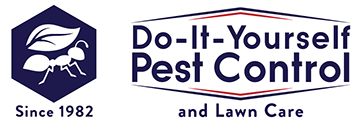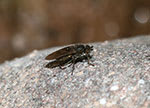
11 Types Of Flies - Fly Identification
Discover the most common types of flies in the USA. Learn the habits and habitats of these pesky creatures in order to get rid of them effectively.
December 18, 2023
Let's discuss one of the most annoying pests known to man - the fly. While we commonly just refer to them all as flies or house flies, there are an incredible amount of different types of flies.
In North America alone, there are over 16,000 different fly species. We won't list all of those fly species here, but we will identify the 11 most common types of flies you will see in the USA.
Fly Species
To successfully prevent and get rid of flies in your home, the first step is to determine which type of fly you are dealing with. Below, we will discuss the habits and life cycles of the most common types of flies, including:
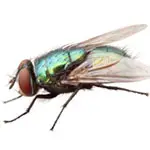
1. Blow Flies and Bottle Flies
The term "bluebottle fly" (also known as the "blowfly") comes from the unique color of the insect, which resembles blue-colored bottles. This type of fly frequently hangs out around trash cans and is drawn to dog waste and dead animals. It is well known that bluebottle flies, or blow flies, may spread illnesses like typhoid, E. coli, TB, and many more.
A bluebottle fly has a relatively brief life cycle. The larval stage lasts for around 2-3 days, and eggs hatch in 0 to 18 hours. The adult stage lasts for about two weeks after the pupae stage, and adults breed primarily in meat-derived items or occasionally in cheese.
If you have identified this type of fly in your home, read this article to learn how to get rid of blowflies.
-
Identifying Characteristics: About twice as large as a house fly; metallic blue or green color.
-
Adult Occurrence: Spring and Summer.
-
Life Cycle: 2-4 weeks.
-
Management Products/Methods: Residual and contact sprays; traps. Sanitation, exclusion, habitat destruction.
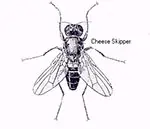
2. Cheese Skipper
Cheese skippers typically eat moldy, overripe cheese that is three months or older, as well as mildly salted or foul-smelling foods like bacon, ham, and beef. The majority of the time, larvae are found on high-protein foods such as salted beef, smoked seafood, and animal carcasses. Eggshells with a pale hue and little grooves or wrinkles on the surface of cheese produced by larvae indicate the presence of a cheese skipper infestation.
Cheeses that are infected by this type of fly typically have soft or sunken portions, while infected areas of meat may exude a glistening substance that resembles grease. Infested materials often have eggs, larvae, pupae, and adults nearby or on them.
Are these flies destroying your cheese? Check out our guide to getting rid of cheese skippers.
- Identifying Characteristics: Black, shiny, with bronze tints.
- Host Material: Moist sources: overripe and moldy cheese, ham.
- Adult Occurrence: Most abundant in warm and moist conditions.
- Life Cycle: 2-3 weeks.
- Management Products/Methods: Pyrethrum contact and fogging sprays. Sanitation and habitat destruction.
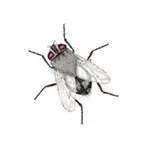
3. Cluster Fly
Cluster flies, also known as attic flies, are frequently found in unoccupied, quiet areas of your home. They assemble in big groups and look for a warm area to hibernate through the chilly winter. Since cluster flies are drawn to the light on sunny days, you might see a sizable group of them gathered around a window in your attic.
Similar Appearance to The House Fly
Late summer or early fall is when cluster flies lay their eggs in the soil. Earthworms host the larva, which matures before molting and pupating in the soil. From egg to adult, development takes roughly 27–39 days.
- Identifying Characteristics: Superficially, it resembles the house fly but these large black flies are slightly larger and more sluggish in their movements.
- Host Material: They are parasites of earthworms and their breeding sites include the outdoors in lawns and fields.
- Adult Occurance: Abundant in spring and fall.
- Life Cycle: 4-6 weeks.
- Management Products/Methods: To get rid of Cluster flies, use residual and contact spray. Screen and caulk around eaves, windows, etc.
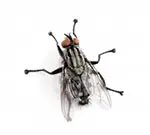
4. Flesh Fly
These are one of the most troublesome types of flies, as they leave painful bites. Flesh flies have a tendency to lay their larvae in rotten meat or the flesh of a dead animal, hence the name.
They resemble house flies in appearance but are a little bigger. Although they are occasionally seen in homes and eateries, flesh flies are common in both urban and rural locations.
The Rapid Life Cycle of the Flesh Fly
Compared to other types of flies, flesh flies have a slightly longer life cycle. Larvae eat for three to fourteen days before leaving to pupate in nearby drier areas. 10-15 days later, they become adults, and their full life cycle takes 2-4 weeks.
Click to discover how to get rid of flesh flies when they infest your home.
- Identifying characteristics: 2 to 3 times larger than a housefly: gray and black checkboard pattern on the abdomen.
- Host Material: Garbage, manure, and animal carcasses.
- Adult Occurrence: Common in warm months.
- Life Cycle: 2-4 weeks.
- Management Products/Methods: Residual and contact sprays; baits, traps, Sanitation, exclusion, habitat destruction.

5. Fruit Fly
Fruit flies, as their name implies, are found around ripe or fermenting vegetables, where they lay eggs. Fruit flies are widespread in homes, eateries, supermarkets, and other places where food is served.
Additionally, they can enter from your garden. Fruit flies may carry diseases, but more often than not, if the larvae are unintentionally eaten, they may upset the stomach and cause diarrhea.
Diet of Fruit Flies
Fruit flies feed on decaying food waste, particularly fruits and vegetables, as well as any fermenting liquids, such as beer, liquor, and wine. Additionally, these common flies are drawn to and occasionally breed in filthy, dark, and moist areas like drains, garbage disposals, and trash bins.
Fruit flies can reproduce quite quickly, which makes it challenging to get rid of them. The 500 eggs that a female fruit fly can lay can hatch in as little as a day. Fruit flies have a four-stage lifecycle that, like those of other fly species, can be finished under the right circumstances in as little as a week.
- Identifying Characteristics: 1/8th inch long; yellowish-brown; hovers around ripe or decaying fruits and vegetables.
- Host Material: Decaying fruits and vegetables; garbage.
- Adult Occurrence: Most abundant in late summer and early fall.
- Life Cycle: 1 to 2 weeks.
- Management Products/Methods: Chemicals and Traps Methods: Residual and contact sprays; baits, traps. Sanitation, exclusion, habitat destruction.

6. Fungus Gnats
Fungus gnats are a small type of fly that attacks soil, other container materials, and other forms of decaying organic matter. Their larvae devour roots and can be a concern in greenhouses, gardens, nurseries, and pot plants.
Their larvae mostly consume fungi and organic debris in the soil. Indoor houseplants may produce adult fungus gnats, which can be a nuisance. These types of flies are not be confused with biting gnats or biting midge flies.
Given that they cannot bite humans and cannot transmit diseases, fungus gnats are harmless to people. However, as their population booms and their larvae begin to feed on the delicate roots of plants, they can become an issue for your houseplants.
- Identifying Characteristics: Fungus gnats are tiny; most are less than 1/16 of an inch, although some may be larger.
- Host Material: The larvae feed on fungus growing in the soil and moist organic matter.
- Adult Occurrence: Most abundant in warm and moist conditions.
- Life Cycle: 2-3 weeks.
- Management Products/Methods: Use chemical and trap methods to get rid of Fungus Gnats. Residual and contact sprays; baits, and traps. Remove contaminated soil and breeding sites.
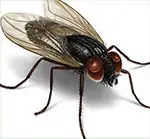
7. House Fly
The most common type of fly in the USA is the house fly. As the name suggests, you will find them buzzing in and around your home.
Adult house flies normally have four black stripes on their thorax and a gray appearance. A house fly's adult length is between 1/8" and 1/4". They have wings, slightly hairy bodies, and compound red eyes with thousands of tiny lenses that give them a larger field of view. Both teeth and a stinger are absent from house flies.
Eggs of House Flies
The eggs of the house fly resemble little grains of rice. The eggs develop into larvae, commonly referred to as maggots, that are between 14 and 3/8" long when they hatch. Maggots have a greasy look and a cream tint.
Maggots gain dark, hard outer shells, legs, and wings as they transition into the pupal stage, eventually emerging as fully developed adult flies.
This ultimate guide will teach you how to get rid of the house flies when they infest your home.
- Identifying Characteristics: 1/4 inch long: dull gray with four stripes on the thorax; 4th wing vein sharply angled.
- Host Material: Animal waste, garbage, and other decaying organic matter.
- Adult Occurrence: Most abundant later in summer and early fall.
- Life Cycle: 7 - 45 Days.
- Management Products/Methods: Residual and contact sprays; baits, traps; larvicides. Sanitation, exclusion, habitat destruction.

8. Drain Fly
Also known as moth flies or sewage flies, these notorious pests live primarily in moist, damp places.
Drain flies are quite tenacious and frequently seen near sewage beds, where their larvae consume organic materials that resemble sludge. When at rest, its heavily-haired wings hold a tent-like form over the body.
Adult drain flies can deposit up to 100 eggs each time they lay, which hatch in around 48 hours. The maturation period for larvae varies from 10 to 50 days, whereas that for pupae is only 1 to 3 days. Drain flies have a lifespan of roughly two weeks.
- Identifying Characteristics: 1/8 inch long; body and wings densely covered with long hairs.
- Adult Occurance: Drain flies are more common in warm months.
- Life Cycle: 2-3 weeks.
- Management Products/Methods: Residual and contact sprays can get rid of drain flies, also apply drain treatment with microbes. Sanitation, habitat destruction, and moisture control.
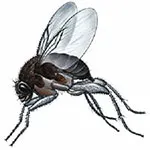
9. Phorid Flies
A phorid fly is a tiny, somewhat humpbacked fly that runs away when you approach it rather than flying. It can be found in nature, usually near decaying plants and dead animals.
This filth fly is also found close to drains, garbage cans, grease traps, crawl spaces, and pretty much everywhere that something is decomposing. It can spread disease since it grows and feeds in such unhygienic settings, so we recommend getting rid of phorid flies as soon as you spot them.
- Identifying Characteristics: They superficially resemble fruit flies, but are more humpbacked.
- Host Material: Decaying vegetation and animal matter.
- Adult Occurrence: Most abundant in warmer months.
- Life Cycle: 1-2 weeks.
- Management Products/Methods: Residual and contact sprays, drain treatment with microbes. Sanitation, habitat destruction, and moisture control.
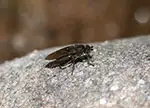
10. Sphaerocherid Fly (Dung Fly)
Sphaerocerid flies are members of the Sphaeroceridae fly family, which has 241 species in the USA.
These flies are common in poultry houses where they breed in chicken dung, but they may also be highly bothersome in residences and places of business.
This type of fly has a similar biology and habitat to fruit flies and phorid flies. They feed on any decomposing organic materials and are commonly found in the same places. Read our top tips to get rid of dung flies here.
- Identifying Characteristics: 1/8-inch; black.
- Host Material: Decaying organic matter, especially moist animal manure.
- Adult Occurrence: Most abundant in warmer months.
- Life Cycle: 2-3 weeks.
- Management Products/Methods: Residual and contact sprays, drain treatment with microbes
- Sanitation, habitat destruction, and moisture control.
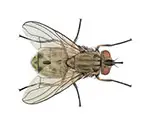
11. Stable flies
The stable fly, or horse fly, is a common pest found on or near horses and other large mammals.
This type of fly ranges in size from 10 to 30 mm and has a gray or blackish body. Stable flies typically have wings without any black spots, but some species have wings that are completely dark. They have broad eyes that are typically striped horizontally in green or purple. Horse flies have a relatively large painful bite.
Powerful Pests
Although adult stable flies often do not disperse extensively, they are quick and powerful and can fly more than 20 miles in one go. Horse flies frequently stop to rest on roads and walkways while waiting for suitable hosts, especially in wooded regions.
Horse flies are drawn to light and may assemble near windows. They are particularly noticeable on hot, windless days. Larvae grow in moist soil near water sources.
Stable flies, or horse flies, do not usually carry disease or spread harmful bacteria. However, horse flies can bite you painfully and trigger allergic reactions.
The horse fly is also relentless, and they won't stop biting their hosts until they get their blood meal—or until they die. Female horse flies need a blood meal to raise their young, making these biting flies one of the worst. Click here to learn how to get rid of stable flies.
- Identifying Characteristics: 1/4-inch; long, pointed proboscis.
- Host Material: decaying hay, straw, fermenting weeds, grass, and seaweeds.
- Adult Occurrence: More common in warm months, after a rain.
- Life Cycle: 3-4 weeks.
- Management Products/Methods: Residual and contact sprays, traps, Sanitation, habitat destruction, and moisture control.
Types Of Flies - Fly Control Identification
Learn about the different types of flies, different species of flies and fly identification.
- Identifying Characteristics: About twice as large as house fly; metallic blue or green color
- Adult Occurrence: Spring and Summer
- Life Cycle: 2-4 weeks
- Management Products/Methods: Residual and contact sprays; traps
Sanitation, exclusion, habitat destruction
- Identifying Characteristics: Black, shiny, with bronze tints
- Host Material: Moist sources: overripe and moldy cheese, ham.
- Adult Occurrence: Most abundant in warm and moist conditions
- Life Cycle: 2-3 weeks
- Management Products/Methods: Pyrethrum contact and fogging sprays
Sanitation and habitat destruction
- Identifying Characteristics: Superficially resemble house fly but is slightly larger and more sluggish in its movements
- Host Material: They are parasites of earthworms and breed outdoors in lawns and fields
- Adult Occurance: Abundant in spring and fall
- Life Cycle: 4-6 weeks
- Management Products/Methods: Residual and contact sprays
Screen and caulk around eaves, windows, etc.
- Identifying Characteristics: 2 to 3 times larger than a housefly: gray and black checkboard pattern on the abdomen.
- Host Material: Garbage, manure, and animal carcasses
- Adult Occurrence: Common in warm months
- Life Cycle: 2-4 weeks
- Management Products/Methods: Residual and contact sprays; baits, traps
Sanitation, exclusion, habitat destruction
- Identifying Characteristics: 1/8th inch long; yellowish-brown; hover around ripe or decaying fruits and vegetables
- Host Material: Decaying fruits and vegetables; garbage
- Adult Occurrence: Most abundant in late summer and early fall
- Life Cycle: 1 to 2 weeks
- Management Products/Methods: Chemical and Traps Methods: Residual and contact sprays; baits, traps
Sanitation, exclusion, habitat destruction.
- Identifying Characteristics: Fungus gnats are tiny; most are less than 1/16 of an inch, although some may be larger.
- Host Material: The larvae feed on fungus growing in the soil and moist organic matter.
- Adult Occurrence: Most abundant in warm and moist conditions
- Life Cycle: 2-3 weeks
- Management Products/Methods: Chemical and Traps Methods: Residual and contact sprays; baits, traps
Remove contaminated soil, breeding sites.
- Identifying Characteristics: 1/4 inch long: dull gray with four stripes on the thorax; 4th wing vein sharply angled
- Host Material: Animal waste, garbage, and other decaying organic matter
- Adult Occurrence: Most abundant later summer and early fall
- Life Cycle: 7-45 Days
- Management Products/Methods: Residual and contact sprays; baits, traps; larvicides
Sanitation, exclusion, habitat destruction
- Identifying Characteristics: 1/8 inch long; body and wings densely covered with long hairs Adult Occurance: More common in warm months
- Life Cycle: 2-3 weeks
- Management Products/Methods: Residual and contact sprays, drain treatment with microbes
Sanitation, habitat destruction, and moisture control
- Identifying Characteristics: Superficially resemble fruit flies, but are more humpbacked.
- Host Material: Decaying vegetation and animal matter
- Adult Occurrence: Most abundant in warmer months
- Life Cycle: 1-2 weeks
- Management Products/Methods: Residual and contact sprays, drain treatment with microbes
Sanitation, habitat destruction, and moisture control
Sphaerocerid Flies (Dung Flies)
- Identifying Characteristics: 1/8-inch; black
- Host Material: Decaying organic matter, especially moist animal manure
- Adult Occurrence: Most abundant in warmer months
- Life Cycle: 2-3 weeks
- Management Products/Methods: Residual and contact sprays, drain treatment with microbes
Sanitation, habitat destruction, and moisture control
- Identifying Characteristics: 1/4-inch; long, pointed proboscis
- Host Material: decaying hay, straw, fermenting weeds, grass, and seaweeds
- Adult Occurrence: More common in warm months, after a rain
- Life Cycle: 3-4 weeks
- Management Products/Methods: Residual and contact sprays, traps
Sanitation, habitat destruction, and moisture control
Written by our resident pest control expert Ken Martin.

